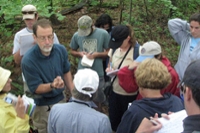This course has been canceled for fall 2016. The following information is provided for reference only.SCIE619The Biology of MammalsGeoff HammersonNote: This is an immersion course with a special schedule.
Location: TBA
|
 |
Course Overview
“Step outside into a forest, field, or residential area, or stroll along a stream or wetland. Search the ground, examine nearby plants, look up into the trees. Careful observation will soon reveal evidence of the often secretive lives of wild mammals. You might find a track in the mud, hole in the ground, or scratched tree trunk, or perhaps a gnawed acorn, a stash of seeds, or chewed plant. All of these hint at intricate relationships and hidden agendas in the natural world. Each year, from concealed nests, emerge new generations of skillful fanged hunters and vast numbers of nibblers and gnawers. This assemblage of predators and prey is impressively diverse in size and habits, but all started life with precisely the same maternal nourishment. In this course, we immerse ourselves in the furred lifestyle and find out what it means to be a wild mammal.”
- Geoff Hammerson
- Full Description
This course investigates the biology of non-marine mammals and focuses on those inhabiting northeastern North America. We examine the lives of familiar mammals such as bears, coyotes, and moose, as well as the secretive existence of shrews, bats, and mice.
Lectures and discussions focus on questions of ecology, behavior, and conservation, such as: What are the different strategies for surviving winter? How do herbivorous mammals cope with toxic chemicals in plants? Why do mating seasons differ so drastically among mammals that inhabit the same environment? How do the various groups of mammals perceive their world? What is the function of the star-nosed mole's peculiar snout? Why are coyotes in New England larger than those in the West? What factors influence a squirrel's decision to eat an acorn or bury it for later use? How do mammals affect and reflect ecosystem characteristics? What is the current status of the gray wolf and mountain lion (cougar) in New England? Why has the Allegheny woodrat disappeared from the region? What is white-nose syndrome?
The course also includes daily field trips and a practical component in which we identify mammals using external physical characteristics, skeletal material, tracks, and other signs. - Evaluation and Grading Procedures
Evaluation and Grading Procedures:
Grading is subjective, based on the instructor’s evaluation of the substance, organization, and written quality of the student’s work. All work will be returned with a grade (A, B+, etc.) and specific suggestions for improvement. Evaluation of the individual research project will also be based on the effectiveness of the online presentation. Additionally, students must participate in and complete all online components of this course.
Moodle website:
It is your responsibility to check the course Moodle website prior to and after each class. This is where you will find important announcements, follow-up information, maps of field trip sites, and details about upcoming field trips.
- Faculty Bio
Geoffrey Hammerson (B.S. University of California, Berkeley; Ph.D. University of Colorado, Boulder) is a research zoologist at NatureServe and is author of more than 70 reports and publications, most recently, Conservation and management of North American leafcutter bees (2016, with B. Young et al., NatureServe, Arlington, VA), The conservation status of the world’s reptiles (Biological Conservation, 2013, with M. Böhm et al.) and Rapid assessment of plant and animal vulnerability to climate change (in Wildlife Conservation in a Changing Climate (University of Chicago Press, 2012, with Young et al.).









